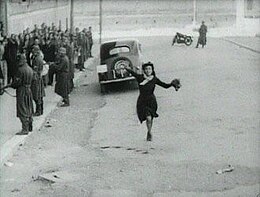Italian neorealist

A still shot from Rome, Open City (1945).
|
|
| Years active | 1944–1952 |
|---|---|
| Country | Italy |
| Major figures | Roberto Rossellini, Vittorio De Sica, Cesare Zavattini, Luchino Visconti, Giuseppe De Santis, Suso Cecchi d'Amico, Federico Fellini |
| Influences | Poetic realism, Marxism, Christian humanism |
| Influenced | French New Wave, Cinema Novo Iranian New Wave |
Italian neorealism (Italian: Neorealismo), also known as the Golden Age of Italian Cinema, is a national film movement characterized by stories set amongst the poor and the working class, filmed on location, frequently using non-professional actors. Italian neorealism films mostly contend with the difficult economic and moral conditions of post-World War II Italy, representing changes in the Italian psyche and conditions of everyday life, including poverty, oppression, injustice, and desperation.
Italian neorealism came about as World War II ended and Benito Mussolini's government fell, causing the Italian film industry to lose its centre. Neorealism was a sign of cultural change and social progress in Italy. Its films presented contemporary stories and ideas and were often shot in streets as the Cinecittà film studios had been damaged significantly during the war.
The neorealist style was developed by a circle of film critics that revolved around the magazine Cinema, including Luchino Visconti, Gianni Puccini, Cesare Zavattini, Giuseppe De Santis and Pietro Ingrao. Largely prevented from writing about politics (the editor-in-chief of the magazine was Vittorio Mussolini, son of Benito Mussolini), the critics attacked the Telefoni Bianchi films that dominated the industry at the time. As a counter to the popular mainstream films, some critics felt that Italian cinema should turn to the realist writers from the turn of the 20th century.
...
Wikipedia
